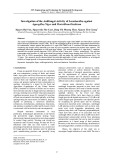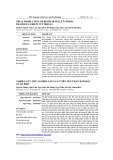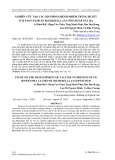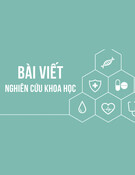
88 Nong Lam University, Ho Chi Minh City
The Journal of Agriculture and Development 23(Special issue 1) www.jad.hcmuaf.edu.vn
Effects of dietary supplementation with probiotics on growth performance, gut health
and disease resistance of striped catfish (Pangasianodon hypophthalmus)
Can T. Vo, Binh T.T. Vo, Dang H. Mai, Binh A. Bach, Hung T. Le, & Tuan V. Vo*
Faculty of Fisheries, Nong Lam University, Ho Chi Minh City, Vietnam
ARTICLE INFO ABSTRACT
Research Paper
Received: August 21, 2024
Revised: October 01, 2024
Accepted: October 08, 2024
Keywords
Edwardsiella ictaluri
Growth performance
Probiotics
Striped catfish
*Corresponding author
Vo Van Tuan
Email:
vovantuan@hcmuaf.edu.vn
This study was conducted to investigate the effects of the probiotic
(Bacillus Liq-Vtech)-supplemented diets on growth performance,
intestinal microbe, morphology of the intestine, and resistance to
Edwarsiella ictaluri infection in striped catfish (Pangasianodon
hypophthalmus). A total of 800 healthy striped catfish (12 ± 2 g)
were randomly divided into four experimental groups with four
replicates each, and were fed diets supplemented with different
levels of Bacillus Liq-Vtech (T1: 0 cfu/g; T2: 0.5 × 106 cfu/g; T3: 1.0 ×
106 cfu/g; and T4: 1.5 × 106 cfu/g) for 8 weeks. At the end of the trial, a
challenge test with Edwardsiella ictaluri was conducted for 2 weeks.
The results showed no statistically significant improvement in the
growth performance and survival rate of fish with Bacillus Liq-
Vtech supplementation (P > 0.05). However, there was a tendency
for the improved growth performance in treatments supplemented
with Bacillus Liq-Vtech. Additionally, the density of Bacillus spp.
increased in the intestinal tract of fish fed probiotic-supplemented
diets compared with the control. All probiotic treatments exhibited
positive effects for different histomorphological features of the
intestine. Mucus secreting goblet cells and villi increased in
probiotic-supplemented groups. Mortality rates in treatments
supplemented with Bacillus Liq-Vtech were lower than those of
the control. These results suggested that the Bacillus Liq-Vtech
supplementation in diets has the potential to improve growth
performance, increase beneficial bacteria in the intestinal tract
of the fish, and reduce the mortality of striped catfish after being
challenged with Edwardsiella ictaluri.
Cited as: Vo, C. T., Vo, B. T. T., Mai, D. H., Bach, B. A., Le, H. T., & Vo, T. V. (2024). Effects of
dietary supplementation with probiotics on growth performance, gut health and disease resistance
of striped catfish (Pangasianodon hypophthalmus). The Journal of Agriculture and Development
23(Special issue 1), 88-99.

Nong Lam University, Ho Chi Minh City 89
The Journal of Agriculture and Development 23(Special issue 1) www.jad.hcmuaf.edu.vn
1. Introduction
Striped catfish, also known as tra catfish
(Pangasianodon hypophthalmus, Sauvage,
1878) is a freshwater species and considered
as an important commercial aquaculture fish
in Vietnam. According to MARD (2024), the
production of striped catfish reached 1.61 million
tons and an export income of approximately 1.8
billion dollars in 2023. Striped catfish has been
intensively cultured in ponds with high stocking
density so that the disease outbreak is a main
risk for the fish farming. Bacterial infectious
diseases are the main agents that caused huge
economic loss for striped catfish industry in
Vietnam (Ferguson et al., 2001; Tu et al., 2008;
Dang & Truong, 2022). Several approaches
such as chemotherapeutics and antibiotics have
been applied to control the infectious diseases
in striped catfish culture, but the application
of these antibiotics and chemotherapeutics is
strictly regulated due to their negative impacts
(Lim et al., 2013; Ramos et al., 2018).
In recent years, there is an increasing
interest in the use of functional feeds that
contain natural supplements such as prebiotics,
probiotics, synbiotics, herbal extracts to improve
fish growth and health, in which probiotics
are considered as a promising solution in
preventing and managing aquatic pathogenic
agents (Ringø & Song, 2016; Bui et al., 2022;
Liaqat et al., 2024). Application of probiotics in
aqua-farming is evident in enhancing growth
performance through ensuring better digestion
with the proliferation of useful bacterial colony
in intestine of fish (Ringø, 2020). A dietary with
probiotics supplementation has been studied in
many aquatic species, such as striped catfish,
channel catfish, tilapia (Nguyen et al., 2022;
Liaqat et al., 2024; Youssef et al., 2024).
The probiotics Bacillus Liq-Vtech (provided
by UV company, Vietnam) is composed of
Bacillus subtilis and Bacillus licheniformis
with a density of 109 cfu/mL. A preliminary
experiment has been proved that it plays an
important role in inhibiting intestinal harmful
bacteria and stimulating immune responses,
leading to prevent diseases and enhance aquatic
animal survival rate. Therefore, the objective of
the present study was to evaluate effects of the
probiotics Bacillus Liq-Vtech-supplemented
diets on growth performance, intestinal microbe
and morphology of the intestine, and resistance of
striped catfish (Pangasianodon hypophthalmus).
2. Materials and Methods
2.1. Experimental diets
Four experimental diets including a basal diet
were formulated to contain different levels of
probiotics Bacillus Liq-Vtech (T1: 0 cfu/g; T2: 0.5
× 106 cfu/g; T3: 1.0 × 106 cfu/g; and T4: 1.5 × 106
cfu/g). The basal diet contained approximately
28% crude protein and 5% lipid, formulated
from different ingredients. All feed ingredients
were thoroughly mixed, extruded and pelleted
to produce a floating feed at Godaco feed mill.
The feed processing involved several stages
as grinding, mixing, conditioning, extrusion
and drying in which the extrusion lasted 5 - 10
min at 120oC and followed by drying at high
temperature of 120 - 150oC. The ingredients and
proximate analyses of the experimental diets was
illustrated in Table 1.
The analyses of proximate composition of
feed ingredients were determined by standard
methods (AOAC, 1995). Crude protein content
was determined by the Kjeldahl method. Crude
lipid content was extracted by n-hexane using
the Soxhlet method. Ash content was determined
by combustion method. Moisture content was
determined by the drying method using an oven
at 105oC.

90 Nong Lam University, Ho Chi Minh City
The Journal of Agriculture and Development 23(Special issue 1) www.jad.hcmuaf.edu.vn
Fish with initial weight of 12 ± 2 g were
selected for the trial. The trial was carried out
in 16 hapas that contained 50 fish per hapa (1.0
m × 2.0 m × 1.5 m). Fish were fed two times a
day (8 am and 16 pm) to apparent satiation for
a period of 8 weeks. One hour after feeding, the
unconsumed feed was collected and dried to
calculate the daily consumed feed for each hapa.
Feed intake was recorded daily to compare the
feeding intake (consumptions) of four diets at
the end of the experiment.
During the feeding trial, water quality
was monitored in order to evaluate the water
quality. Water temperature, dissolved oxygen
(DO) and pH were daily monitored using a
multi-parameters photome (Hanna, Italy). Total
ammonium nitrogen was weekly checked by
TAN meter (Hanna, Italy).
Table 1. Feed formulation of the basal diet and its estimated nutrient analysis
Ingredients Percentage (%)
Rice bran 33.20
Fishmeal 60% 4.00
Soybean meal 47.09
Cassava 14.00
L-Lysine 0.03
DCP 0.63
DL Methionine 0.36
Choline Chloride 0.15
Stay Vitamin C 0.04
Premix 0.50
Nutrient level % Dry matter
Crude protein (%) 28.00
Crude fat (%) 5.60
Fiber (%) 4.02
Ash (%) 8.90
Lysine (%) 1.55
Methionine (%) 0.70
Gross energy 4200 Kcal/kg
From the basal diet, three probiotics Bacillus
Liq-Vtech treatment diets were produced in the
laboratory by coating with probiotics at different
dosages. Then all four diets were finally coated
with 0.5% soy oil to prevent the probiotics
leaching. All prepared feed were stored at 20oC
and labelled as T1, T2, T3 and T4.
2.2. Experimental animals
Striped catfish fingerlings were purchased
from private fish farm at An Giang province and
transported to the Experimental Farm of Nong
Lam University, Ho Chi Minh City, Vietnam. The
fish were acclimated and cultured for 2 weeks
and fed on a basal diet twice daily to apparent
satiation.

Nong Lam University, Ho Chi Minh City 91
The Journal of Agriculture and Development 23(Special issue 1) www.jad.hcmuaf.edu.vn
randomly selected and transferred to 100 L
plastic tanks. Fish were subjected to a two-
hour immersion challenge with E. ictaluri at a
dosage of 2.6 × 106 cfu/mL. The concentration
of bacteria in the suspension was determined
through spectrophotometry at an absorbance of
600 nm and serial plate count method. Fish were
housed in plastic tanks supplied with aeration
and mortality of fish was monitored. At the end
of the trial, survival rate and intestinal microbial
(total bacteria counts and Bacillus sp. counts)
were recorded.
2.4. Analysis of bacteria in fish intestine
At the end of the trial, two fish per hapa
were randomly sampled and anaesthetized with
tricaine methanesulfonate (MS - 222) with a
dosage of 80 mg/L. Approximately 6 - 8 cm of fish
hindgut was aseptically excised, then the inside
of the intestine was gently removed and washed
two times with sterile distilled saline water.
The intestine samples were then homogenized,
suspended in 9 mL of sterile distilled saline
(0.9%), and serially diluted of suspension to 10-5
in 9 mL of sterile distilled saline. 0.1 mL aliquot
from each dilution was spread onto duplicate
PCA (plate count agar, Himedia) and HiCrome
Bacillus Agar Base (Himedia). Plates were
incubated at 28°C for 24 h. Plates containing
between 30 and 300 colony-forming units (cfu)
were used to enumerate the number of total
cultivable bacteria and Bacillus sp. The results
were expressed as cfu/g sample.
2.5. Histological analysis
To analyze the histo-morphological structure
of the stripped catfish intestine, fragments of the
middle portion of the intestine were removed
with sterilized surgical instruments and fixed in
10% buffered formalin solution for 48 h, then
At the end of the trial, consumed feed and
survival rate of fish were measured to determine
the effect of Bacillus Liq-Vtech supplementation
on fish growth and feed utilization. Besides,
intestinal microbial and histology of striped
catfish intestine were also measured. Parameters
were analyzed as follows:
• SR (Survival rates): %)
SR (%) = (Number of survival fish/Number of
initial fish) × 100
• DWG (Daily weight gain): g/fish per day
DWG = (Final weigh - Initial weight)/
Cultured days
• WG (Weight gain): %
WG = (Final weight - Initial weight)/Initial weight
• Specific growth rate (SGR).
SGR (%.day1) = [(Ln(final weight) - Ln(Initial
weight))/Cultured days)] × 100
• Feed conversion ratio (FCR)
FCR = Consumed feed/Weight gain
• Feed intake (FI)
•FI (g/fish per day) = (Consumed feed in
tank/Number fish of tank)/Cultured days
2.3. Bacterial challenge
To evaluate the effect of Bacillus Liq-Vtech
supplements on fish health status, fish were
subjected to an immersion challenge with
pathogenic bacteria E. ictaluri. At the end of
the feeding period, 20 fish in each hapa were

92 Nong Lam University, Ho Chi Minh City
The Journal of Agriculture and Development 23(Special issue 1) www.jad.hcmuaf.edu.vn
groups. The probability values of P < 0.05 were
applied to confirm the statistical difference.
3. Results
3.1. Water quality
Water quality which directly affect to
reproduction, growth, and survival of aquatic
organisms are considered as the most important
factors in aquaculture. Aquatic organisms are
susceptible to suffer stress when ecological
conditions are not adequate. High stress levels
generate low feeding and low growing rates as
well, resulting in the appearing of sickness in
the organisms (Chainark & Boyd, 2010). Striped
catfish are also aquatic species but can use their
swim bladder to breath air, so the demand of
dissolved oxygen is not strictly required high like
other fish.
During the trial, water quality parameters
such as temperature, pH, DO, total ammonia
nitrogen (TAN) were sampled and the results
were illustrated in Table 4.
dehydrated in graded ethanol concentrations,
cleared in xylene, and embedded in paraffin wax.
Sections of 5 µM thickness were stained with
Alcian blue (AB) and periodic-acid stain (PAS),
and analyzed under light microscope.
To determine the height of the intestinal
epithelium, five random villi per histological
section were measured according to the
structural characteristics. The number of goblet
cells was counted and expressed in number per
µM2 of villi. The images were obtained with
digital camera attached to a photomicroscope
and analyzed by the program Image J.
2.6. Statistical analysis
Results were presented as means ±
standard deviation (SD). All data were firstly
examined for homogeneity of variance using
SPSS statistic 20.0 software (IBM, New York,
USA). One-way ANOVA was used to test the
main effect of different diets to fish growth.
The Duncan test was used to determine the
significant differences among treatment
Table 4. Water quality parameters of the trial
Water quality parameters
Temperature
(oC) pH Dissolved oxygen
(mg/L) TAN
(mg/L)
Morning Afternoon Morning Afternoon Morning Afternoon
29.7 ± 0.7 31.5 ± 0.9 7.1 ± 0.3 8.3 ± 1.1 2.6 ± 0.5 4.0 ± 1.6 0.10 ± 0.21
Results are mean of 8 weeks; TAN: total ammonia nitrogen.
The results showed that the water temperature
in the morning was lower, but not significant
difference in compared to the one in the
afternoon (P > 0.05). pH and dissolved oxygen
(DO) are the most important factors affecting the
growth and the health status of aquatic animals.
They are also important limiting factors for
cultivation activities of all aquatic organisms to
survive and grow (Dandruff & Dean, 1967; Boyd,
2001). During the culture season, pH should be



![Đề cương môn Vi sinh vật thú y [chuẩn nhất]](https://cdn.tailieu.vn/images/document/thumbnail/2025/20250414/trantrongkim2025/135x160/1263896842.jpg)






















